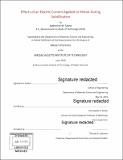| dc.contributor.advisor | Christopher A. Schuh. | en_US |
| dc.contributor.author | Stone, Katherine M. | en_US |
| dc.contributor.other | Massachusetts Institute of Technology. Department of Materials Science and Engineering. | en_US |
| dc.date.accessioned | 2019-10-04T21:35:04Z | |
| dc.date.available | 2019-10-04T21:35:04Z | |
| dc.date.issued | 2019 | en_US |
| dc.identifier.uri | https://hdl.handle.net/1721.1/122446 | |
| dc.description | Thesis: S.M., Massachusetts Institute of Technology, Department of Materials Science and Engineering, 2019 | en_US |
| dc.description | "June 2019." Cataloged from PDF version of thesis. | en_US |
| dc.description | Includes bibliographical references (pages 31-34). | en_US |
| dc.description.abstract | Solidification is an important, yet not fully understood, materials process. One way to better understand solidification, or at least to better control it, is through applying outside effects onto the solidifying material. Private industrial experiments performed by Dr. Eric Dahlgren suggested that there might be a trend of increased undercooling in a metallic sample as more current was applied. An expansion of those experiments was commenced to A) confirm this trend and B) explore its potential causes, with the ultimate goal of being able to reliably change undercooling in a metallic material to affect its final properties. An experiment was designed where gallium could be subjected to between o and 20 amps of applied direct current. The gallium sample could then be cooled, while its thermal history over time could be recorded. The cooling curves of the gallium between melting and recalescence points were then used to try and quantify the effect of the applied current. It was shown that increasing the applied current did increase the undercooling time, specifically the time to homogenous nucleation. Although no mechanism to explain this phenomenon has been conclusively proved, this project was able to help reduce the likelihood of several theories. Simple calculations showed that joule heating does not create enough heat flux to change the temperature and effect the formation of nuclei in the melt. Experimental results showed that the observed phenomenon was due to the effects on a nucleation-based process, not a growth process, disproving several growth-based theories for this phenomenon. Additionally, certain common assumptions in previous experiments about the effects of a magnetic field, or of joule heating, were disproven. These advances, and some of the setbacks experienced in this project, lay a path for improvements in future work that may find the precise cause of this effect. | en_US |
| dc.description.statementofresponsibility | by Katherine M. Stone. | en_US |
| dc.format.extent | 34 pages | en_US |
| dc.language.iso | eng | en_US |
| dc.publisher | Massachusetts Institute of Technology | en_US |
| dc.rights | MIT theses are protected by copyright. They may be viewed, downloaded, or printed from this source but further reproduction or distribution in any format is prohibited without written permission. | en_US |
| dc.rights.uri | http://dspace.mit.edu/handle/1721.1/7582 | en_US |
| dc.subject | Materials Science and Engineering. | en_US |
| dc.title | Effects of an electric current applied to metals during solidification | en_US |
| dc.type | Thesis | en_US |
| dc.description.degree | S.M. | en_US |
| dc.contributor.department | Massachusetts Institute of Technology. Department of Materials Science and Engineering | en_US |
| dc.identifier.oclc | 1120771521 | en_US |
| dc.description.collection | S.M. Massachusetts Institute of Technology, Department of Materials Science and Engineering | en_US |
| dspace.imported | 2019-10-04T21:35:03Z | en_US |
| mit.thesis.degree | Master | en_US |
| mit.thesis.department | MatSci | en_US |
